How I Trained for Suborbital Spaceflight (A Photo Guide)
Day One: Arrival at NASTAR
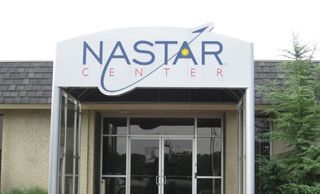
SPACE.com Senior Writer Clara Moskowitz: It’s Day One of my 3-day spaceflight training program at the Pennsylvania NASTAR facility and I’m unsure of what to expect. The facility coaches scientists and tourists planning on suborbital rides, plus it hosts a plethora of other space and aviation simulators for pilots of all stripes.
Suit Up for Space Training
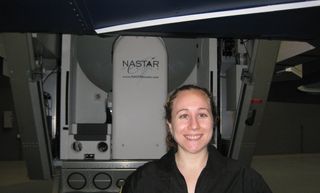
After arriving we were fitted up with space jumpsuits to get us feeling like astronauts. Here, I pose in front of the centrifuge’s cockpit, where I am about to strap in for some added Gs. — Clara Moskowitz.
Spin Up!
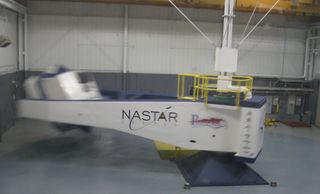
Our first training runs were a relatively mild 2 G’s (twice the force of gravity), but by day three we were dealing with 6 G’s and forces in two directions. Here, the centrifuge arm spins to simulate extra gravity with centrifugal force. — Clara Moskowitz.
Hitting the Books
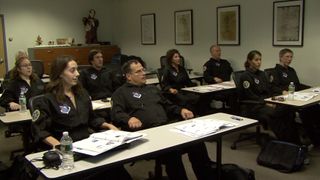
My fellow trainees and I sit in NASTAR’s classroom while an instructor teaches us what to expect from our mock spaceflights. The other participants were all research scientists preparing to take experiments to space to take advantage of microgravity. — Clara Moskowitz.
The Hot Seat
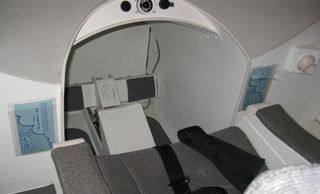
A view inside the cockpit of the centrifuge shows the chair where we're strapped in, as well as the "motion sickness bags," just in case. — Clara Moskowitz.
Inside the Centrifuge
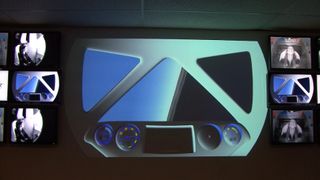
While each trainee rode on the simulator, the rest of us looked on in jealousy (or in my case, abject terror) from a viewing room above. The center screen is the view from the cockpit, showing the simulated sights of the flight, while the side panels show our compatriot from different angles during the ride. — Clara Moskowitz.
Waiting for "Blastoff"
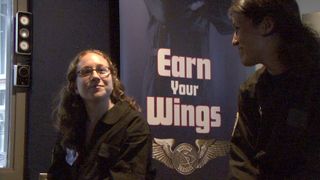
At NASTAR's spaceflight training, I went last of all seven trainees, so I had plenty of time to build up my panic as each person weathered the storm before me. Here I sit with fellow student Kara Beaton of Johns Hopkins University. — Clara Moskowitz.
Get the Space.com Newsletter
Breaking space news, the latest updates on rocket launches, skywatching events and more!
Have Helmet, Will Travel
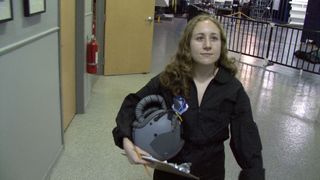
At NASTAR, we also underwent pressure training in a hypobaric chamber to feel what it's like when the air is slowly sucked out of a room (fun!). Here I walk toward the chamber holding my oxygen mask, which we wore in case we needed an emergency hit of air. — Clara Moskowitz.
Breathing Easy
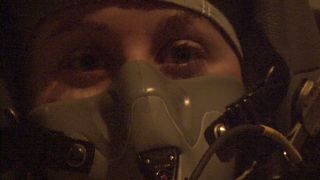
In the oxygen mask while sitting in the NASTAR's hypobaric chamber. I look just like Tom Cruise in Top Gun – right? — Clara Moskowitz.
G Forces ... Rising
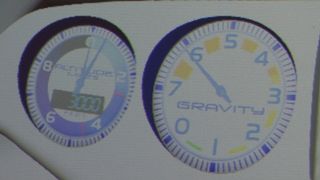
While riding on the centrifuge, these gauges showed our simulated altitude and gravity forces at all times. The highest we went was 6 Gs, though some training programs pack on even more. — Clara Moskowitz.
In the Waiting Room
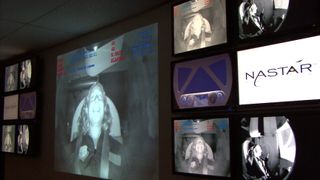
A shot from the NASTAR viewing room while I rode the simulator, with me strapped in as my "spaceship" took off. — Clara Moskowitz.
Join our Space Forums to keep talking space on the latest missions, night sky and more! And if you have a news tip, correction or comment, let us know at: community@space.com.

Clara Moskowitz is a science and space writer who joined the Space.com team in 2008 and served as Assistant Managing Editor from 2011 to 2013. Clara has a bachelor's degree in astronomy and physics from Wesleyan University, and a graduate certificate in science writing from the University of California, Santa Cruz. She covers everything from astronomy to human spaceflight and once aced a NASTAR suborbital spaceflight training program for space missions. Clara is currently Associate Editor of Scientific American. To see her latest project is, follow Clara on Twitter.